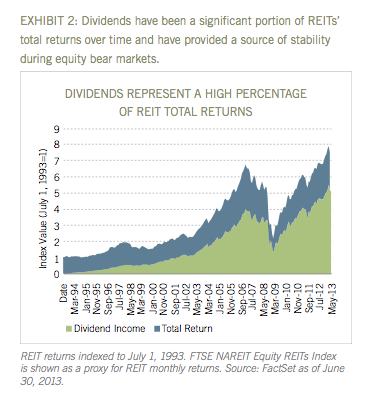3 HighYield REITs That Could Sink Your Portfolio
Post on: 29 Март, 2015 No Comment

Tim Plaehn March 3, 2015 Comments Off
My first selection criteria for dividend stocks, such as real estate investment trusts, REITs, is to screen for yield vs. dividend growth. To ferret out the best combinations of yield and dividend growth, I develop, maintain and regularly update several spreadsheets to quickly sort selected stocks by either yield or dividend growth. This strategy helps me to pick out only the highest quality dividend stocks, which I then recommend to you.
As a dividend-focused investor, you can use a yield versus growth strategy in different ways. For my Dividend Hunter newsletter, I look for well above average yields with moderate dividend growth that indicate to me a company has a strategy to grow cash flow and support investors. For my 30 Day Dividends newsletter, the focus is on high dividend growth companies, which have the potential to produce total annual returns of 20% or more (most on the “more” side of that).
I also track the average yields for different categories of income stocks, which allows me to make sure I find those that will produce above average yields or return. A multi-year history of no dividend increases is the one income stock characteristic that causes me to definitely avoid a stock. I have no use for a corporate management team that cannot figure out how to increase cash payments to investors.
My REIT database includes 120 companies, which covers the equity REITs with market caps of about $1 billion and up. Out of that group about two-thirds or 82 REITs have been growing dividends. The other third, or 39 REITs have not been growing dividends or are too new to the market to have yet built a dividend payment track record. What I find a little surprising is that the average yield of the dividend growers, which averaged double-digit dividend growth over the last year, is 3.63% and the no-growth crowd is yielding on average just a little more at 3.93%. Today I am going to list the three highest yielding no-growth REITs, and then suggest some alternatives that have similar yields but have been increasing their payouts to investors.
High-Yield, No-Growth REITs (Sell these!)
Government Properties Income Trust (NYSE:GOV) is a $1.6 billion market cap REIT that lives up to its name by leasing properties to government agencies. GOV yields 7.43% and has not increased its quarterly dividend since the third quarter of 2012.
Senior Housing Properties Trust (NYSE:SNH) is a $5.3 billion REIT that owns independent living and assisted living communities, continuing care retirement communities, nursing homes, wellness centers and medical office, clinic and biotech laboratory buildings. Despite its name, SNH has close to half its portfolio in medical office properties. This REIT yields 6.94%, and also has gone 2 1/2 years –since October 2012– without a dividend increase.
Franklin Street Properties Corp. (NYSE:FSP) is a $1.3 billion REIT that owns multi-tenant office buildings. FSP yields 5.99% and has not changed its quarterly dividend rate since July 2008. Ouch!
High-Yield REITs with Growing Dividends (Buy these.)
Select Income REIT (NYSE:SIR) has sold off after its Q4 earnings came up short of expectations, and now yields 8.1%. SIR has increased its dividend rate three times since going public in the Spring of 2012, with the last increase of 4.3% occurring one year ago, so the company may be due to announce another increase in April. Of interest is that SIR is managed by the same third party management company that manages GOV.
Hospitality Properties Trust (NYSE:HPT) is a lodging REIT that yields 6.31%. Earlier this week I covered high growth rate lodging REITs. and HPT is not one of those. Dividend growth was 2% over the last year.
Chambers Street Properties (NYSE:CSG) owns industrial and office properties and currently yields 6.2%. CSG pays a monthly dividend and in January raised the monthly payout by a modest 1.2%.
The REITs discussed above were picked primarily to show that investors can get both high yields and dividend growth, with yields that compare to the highest no growth yields. More research would be required to see if these companies meet my other income stock criteria. The last time I updated my REIT database I did find a REIT with a 6% yield and 10%+ dividend growth. That REIT is now the March addition to The Dividend Hunter recommendations list.
REITs have been an integral part of the income strategy with my newsletter, The Dividend Hunter . since the very beginning. And those growing their dividend payments are strong, consistent dividend payers like the others currently in my Monthly Dividend Paycheck Calendar .
The Monthly Dividend Paycheck Calendar is set up to make sure you’re getting 6, 7, even 10 dividend paychecks per month from stable, reliable stocks with high yields. March has 5 payments left and April could give you 8 payments if you’re signed up in time.
The calendar ensures that your dividend stock income stream will be more stable and predictable as you’re getting payments every month, not just once a quarter like some investors do.
The Monthly Dividend Paycheck Calendar tells you when you need to own the stock, when to expect your next payout, and how much you could make from stable, low-risk stocks paying upwards of 8%, 10%, even 17% in the case of one of them. I’ve done all the research and hard work; all you have to do is pick the stocks and how much you want to get paid.
The next critical date this month comes on Friday, March 6th. so you’ll want to take action now to make sure you don’t miss out. Click here to find out more about this unique, easy way of collecting monthly dividends .














